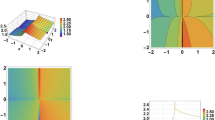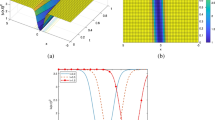Abstract
A numerically efficient broadband, range-dependent propagation model is proposed, which incorporates the Hamiltonian method into the coupled-mode model DGMCM. The Hamiltonian method is highly efficient for finding broadband eigenvalues, and DGMCM is an accurate model for range-dependent propagation in the frequency domain. Consequently, the proposed broadband model combining the Hamiltonian method and DGMCM has significant virtue in terms of both efficiency and accuracy. Numerical simulations are also provided. The numerical results indicate that the proposed model has a better performance over the broadband model using the Fourier synthesis and COUPLE, while retaining the same level of accuracy.
Similar content being viewed by others
References
F. B. Jensen, W. A. Kuperman, M. B. Porter, and H. Schmidt, Com- putational Ocean Acoustics (2nd ed.) (Springer, New York, 2011), p. 611.
W. Munk, P. Worcester, and C. Wunsch, Ocean Acoustic Tomography (Cambridge University Press, New York, 1995), p. 183.
H. Schmidt, and W. A. Kuperman, J. Acoust. Soc. Am. 96, 386 (1994).
G. A. Athanassoulis, and E. K. Skarsoulis, J. Acoust. Soc. Am. 97, 3575 (1995).
F. B. Jensen, IEEE J. Ocean. Eng. 13, 186 (1988).
R. A. Koch, and D. P. Knobles, J. Acoust. Soc. Am. 98, 1682 (1995).
D. P. Knobles, and R. A. Koch, IEEE J. Oceanic Eng. 21, 1 (1996).
I. Tolstoy, J. Acoust. Soc. Am. 44, 675 (1968).
M. B. Porter, J. Acoust. Soc. Am. 87, 2013 (1990).
M. D. Collins, J. Acoust. Soc. Am. 84, 2114 (1988).
M. D. Collins, J. Acoust. Soc. Am. 86, 1097 (1989).
E. K. Skarsoulis, J. Comp. Acous. 05, 355 (1997).
Y. Zhu, R. H. Zhang, and G. L. J, Chin. J. Acoust. 20, 289 (1995).
J. F. Miller, and S. N. Wolf, Model acoustic transmission loss (moatl), Technical Report, (Naval Research Laboratory, Washington, 1980).
C. T. Tindle, and N. R. Chapman, J. Acoust. Soc. Am. 96, 1777 (1994).
N. Wang, and H. Z. Wang, J. Comp. Acous. 18, 259 (2010).
H. Wang, N. Wang, and D. Gao, J. Acoust. Soc. Am. 131, 1047 (2012).
R. B. Evans, J. Acoust. Soc. Am. 74, 188 (1983).
R. B. Evans, J. Acoust. Soc. Am. 80, 1414 (1986).
W. Y. Luo, C. M. Yang, J. X. Qin, and R. H. Zhang, Sci. China-Phys. Mech. Astron. 55, 572 (2012).
W. Y. Luo, X. L. Yu, X. F. Yang, Z. Z. Zhang, and R. H. Zhang, Chin. Phys. B 25, 124309 (2016).
A. V. Oppenheim, and R. W. Schafer, Discrete-Time Signal Processing (Prentice Hall, Upper Saddle River, 1989), p. 629.
Author information
Authors and Affiliations
Corresponding author
Rights and permissions
About this article
Cite this article
Yang, X., Luo, W., Wang, H. et al. An efficient broadband coupled-mode model using the Hamiltonian method for modal solutions. Sci. China Phys. Mech. Astron. 60, 094312 (2017). https://doi.org/10.1007/s11433-017-9066-5
Received:
Accepted:
Published:
DOI: https://doi.org/10.1007/s11433-017-9066-5




